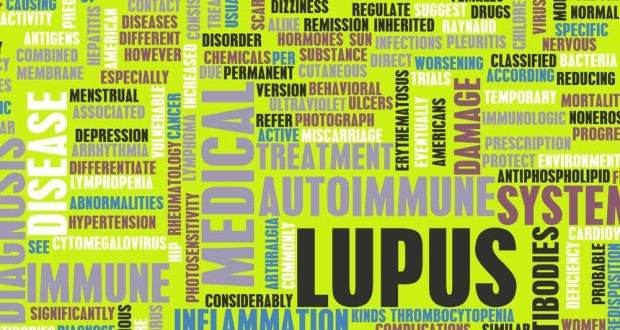When the body falls ill, people generally assume that their illness is due to the presence of some foreign invader. While this is usually the case, there are occasions when the body is quite literally its own worst enemy. One such example is lupus, an autoimmune disorder that causes your immune system to attack the very body it is supposed to defend. Though there is no cure for Lupus, researchers continue to look for ways to better combat this onerous disease.
Lupus is diagnosed in a patient when the body’s immune system begins to attack the body’s tissues and organs. Essentially, the immune system loses its ability to tell the difference between enemy toxins and normal tissues. What makes lupus so difficult to identify is that it can strike at any part of the body – a patient’s skin, lungs, blood cells, brain, heart, lungs and joints are among the body parts that can be affected. If fact, symptoms vary so widely from patient to patient that no two cases are exactly alike. Lupus also imitates a number of other diseases, making the disorder even harder to diagnose.
Because of the nature of the disease, Lupus patients expect to suffer from a wide range of symptoms. These symptoms are noted in the following list:
- Fatigue and Fever
- Join Pain and Swelling
- A distinct rash in the shape of a butterfly on the cheeks and bridge of the nose
- Skin lesions that are vulnerable to sun light
- Your fingers and toes may turn white if exposed to cold, or if you are under stress
- Shortness of breath
- Dry eyes
- Headaches, confusion and memory loss
A patient may experience additional symptoms depending on which areas are affected by the disease. Below is a list of symptoms that are specifically related to certain parts of the body
Brain/Nervous System: headaches, numbness, tingling, seizures, vision problems, personality changes
Digestive tract: abdominal pain, nausea, and vomiting
Heart: abnormal heart rhythms
Lung: coughing up blood and difficulty breathing
Skin: patchy skin color, fingers that change color when cold
Another troublesome characteristic of the disease is that the strength of a case of lupus may wax and wane; in other words, it may go into remission for a period of time before coming back with a vengeance.
The Lupus Foundation of America estimates that 1.5 million Americans currently have lupus, with 16,000 new cases diagnosed annually. Lupus is not contagious, and is not related to other diseases like HIV and cancer. Though anyone can develop lupus, the groups at the highest risk of developing this condition are women of color and women of child-bearing age (15 – 44).
Diagnosing Lupus
To date, there is no single test that can identify lupus. In order to diagnose a patient with this condition, a doctor must run a slew of tests that look for signs of inflammation in the patient. These tests could include antibody tests, complete blood counts, chest x-rays, kidney biopsies and urinalysis. When treating a patient, a doctor may also look at a patient’s current symptoms, a patient’s medical history, and a patient’s family history. After reviewing all of this collected data, a doctor may diagnose a patient with lupus.
Controlling the Disease
Though there is still no cure for this disease, medical science has developed ways of reducing the symptoms of lupus. Methods for treating the disease vary based on the severity of the patient’s symptoms. Mild cases of lupus are treated with nonsteroidal anti-inflammatory medications (NSAIDs), corticosteroid creams, low-dose corticosteroids and an anti-malaria drug known as hydroxychloroquine. NSAIDs are used for arthritis and pleurisy (inflammation of the chest and lungs), the corticosteroid creams fight skin rashes whereas the low-dose corticosteroids and malaria drug treat both skin and arthritis symptoms.
In more severe cases of lupus, the immune system response may have to be partially blocked by high-dose corticosteroids and other medications. If these treatments do not work, a doctor may offer a patient the chance to take cytotoxic drugs, which stymie cell growth. These medications carry a substantial amount of risk, and require careful supervision by a prescribing doctor over an extended period of time.
Natural Treatments to Help Alleviate Symptoms
Lupus is a very serious disease, one that can possibly be life-threatening. Because of its potential severity, a patient should always consult with a doctor about treatments for lupus. Though they cannot replace traditional treatment methods, the following natural remedies can prove beneficial to lupus patients when used in conjunction with prescribed medications:
Omega 3 fatty acids – These essential fatty acids can reduce inflammation caused by lupus
Ginger and Turmeric – Both of these herbs have been known to help curb arthritis symptoms
Vitamin D Calcium Supplements – While corticosteroids can alleviate lupus-induced inflammation, they also present the side effect of weakening a patient’s bones. Vitamin D calcium supplements help to counteract this problem.
While Lupus may never fully leave a patient, it can be managed and pushed into remission through modern medical practices. Natural remedies can also be of service when treating this chronic autoimmune condition. Through a combination of effort, patience and medicine, a lupus patient can reduce the symptoms of his or her condition to a more tolerable level.
 Natural Knowledge 24/7 Educate yourself with nutrition, health and fitness knowledge.
Natural Knowledge 24/7 Educate yourself with nutrition, health and fitness knowledge.






